Top 10 Film Duos: Films to See Before Kick-Ass 2
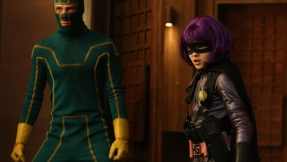 With the release of the sequel to the 2010 film Kick-Ass just around the corner (14th August in the United Kingdom, 16th of August in the United States and the 22nd of August in Australia) and with controversy still as high as the previous film, Kick-Ass/Dave Lizewski (Aaron Taylor-Johnson) and Hit-Girl/Mindy McCready (Chloë Grace Moretz) are sure to return with a bang. With Dave now a fully-fledged superhero, and Hit-Girl at his side, along with several new faces, such as Jim Carrey as ‘Colonel Stars and Stripes’ and Christopher Mintz-Plasse returning as Chris D’Amico, under the new guise of the ‘The Mother Fucker’, this seems to be one of the most anticipated sequels of this year, despite the fact that Vaughn is not directing. However, if the trailers are anything to go by, Kick-Ass 2 is well on its way to being just as funny and awesome as its predecessor. The two central characters, being Kick-Ass and Hit-Girl, have had a rocky relationship, with Dave being personally responsible for her father’s (Nicholas Cage) death, they are now a partnership, training together and fighting crime together.
With the release of the sequel to the 2010 film Kick-Ass just around the corner (14th August in the United Kingdom, 16th of August in the United States and the 22nd of August in Australia) and with controversy still as high as the previous film, Kick-Ass/Dave Lizewski (Aaron Taylor-Johnson) and Hit-Girl/Mindy McCready (Chloë Grace Moretz) are sure to return with a bang. With Dave now a fully-fledged superhero, and Hit-Girl at his side, along with several new faces, such as Jim Carrey as ‘Colonel Stars and Stripes’ and Christopher Mintz-Plasse returning as Chris D’Amico, under the new guise of the ‘The Mother Fucker’, this seems to be one of the most anticipated sequels of this year, despite the fact that Vaughn is not directing. However, if the trailers are anything to go by, Kick-Ass 2 is well on its way to being just as funny and awesome as its predecessor. The two central characters, being Kick-Ass and Hit-Girl, have had a rocky relationship, with Dave being personally responsible for her father’s (Nicholas Cage) death, they are now a partnership, training together and fighting crime together.
In preparation for Kick-Ass 2, let’s look at some of the best duos of cinema, the actors behind them and what made them so great. Please note that the following list excludes romantic couples and will feature a limited amount of spoilers, so be wary.
10. Raoul Duke and Dr. Gonzo (Johnny Depp and Benecio Del Toro) in Fear and Loathing in Las Vegas (1998)
Raoul Duke: “Look, there’s two women fucking a polar bear!”
Dr. Gonzo: “Don’t tell me those things. Not now, man.”
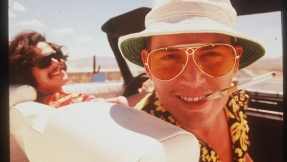 You know you have a strong lawyer-client relationship when your lawyer trusts you to throw a portable radio into your bath-tub while he is high on acid. However, it is these moments which make this partnership such a beauty to watch, like watching a baby who eats sugar for the first time and is surprised to find himself a couple of minutes later covered in what was formerly their birthday cake. Crazy and unfettered by logic; fuelled by pure desire and mental destabilisation.
You know you have a strong lawyer-client relationship when your lawyer trusts you to throw a portable radio into your bath-tub while he is high on acid. However, it is these moments which make this partnership such a beauty to watch, like watching a baby who eats sugar for the first time and is surprised to find himself a couple of minutes later covered in what was formerly their birthday cake. Crazy and unfettered by logic; fuelled by pure desire and mental destabilisation.
Terry Gilliam’s Fear and Loathing in Las Vegas, based on Hunter S. Thompson’s novel of the same name, tells the story (or lack thereof) of a journalist (Duke) and his attorney (Gonzo) on a trip to Las Vegas, to research a story on a motorcycle race called the “Mint 400”. However, along the way they get sidetracked by the dangerous highs they receive from the collection of illicit drugs they are hauling. However, what is happening is really irrelevant, as we take the ride with them, jumping from place to place, as they rip Las Vegas apart.
Yet, it is the dynamic between Del Toro and Depp which drives the movie forward, as you have no idea what they are going to do next, and have no sense of care for the other. Yet, they are both made of the same crazy genes, driven to create chaos, “too weird to live, and too rare to die”, and it is this which means they are meant for each other. Without a common goal or destination, they are extremely unlike our aforementioned “superheroes”, but nonetheless, they have a modicum of a sense of good and evil, as they finely ride that line down the road of fear and loathing, searching for the “American Dream”.
9. Lloyd Christmas and Harry Dunne (Jim Carrey and Jeff Daniels) in Dumb and Dumber (1994)
Harry: “I thought the Rocky Mountains would be a little rockier than this.”
Lloyd: “Yeah, that John Denver is full of shit, man.”
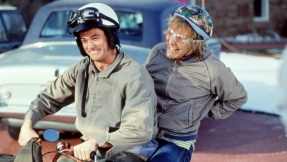 The two stupid-est of the bunch also act the most like friends, finding that balance between self-aware care, playful jokes and acts of cheeky meanness. Oblivious to almost everything that is going on around them, or even what is happening to them, they, too, were meant for each other.
The two stupid-est of the bunch also act the most like friends, finding that balance between self-aware care, playful jokes and acts of cheeky meanness. Oblivious to almost everything that is going on around them, or even what is happening to them, they, too, were meant for each other.
The Farrelly brothers-directed Dumb and Dumber (1994) depicts the simple plot of Lloyd, a limousine driver and Harry, a dog groomer, who travel to Aspen to return a bag which a client of Harry’s left at the airport. However, the audience learns that she left the bag there intentionally, for it to be picked up by two ‘goons’. The constant back-and-forth line deliveries between the two are what carries the movie, as they each unknowingly strive to be more stupid than the other.
They are the embodiment of what friendship means, even though they are barely aware that they need each other in order to survive. Despite each bad decision that they will make, they will strive together for that “break” to come around the corner.
8. C-3P0 and R2-D2 (voiced by Anthony Daniels and Ken Burtt) in Star Wars: Episodes I-VI (1977-2005)
C-3PO: “I thought that hairy beast would be the end of me.”
[R2-D2 bleeps an inquiry]
C-3PO: “Of course I’ve looked better.” -Star Wars: Episode V: The Empire Strikes Back
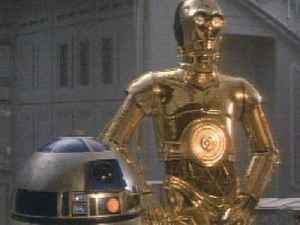 Watching these two is like watching a junkie arguing with what he believes is a conscious wall down at the local train station: no matter what he says the wall will always disagree and those who are watching in apprehensive curiosity are only wondering what the wall is saying back. And, god, it is entertaining. The two droids are undeniably the “comic relief” characters of the film, but they have also become a massive part of popular culture and made an indelible mark on cinema, as one of the best film duos.
Watching these two is like watching a junkie arguing with what he believes is a conscious wall down at the local train station: no matter what he says the wall will always disagree and those who are watching in apprehensive curiosity are only wondering what the wall is saying back. And, god, it is entertaining. The two droids are undeniably the “comic relief” characters of the film, but they have also become a massive part of popular culture and made an indelible mark on cinema, as one of the best film duos.
Spanning the sextet, the prissy protocol droid and the acerbic astromech droid, are two of four characters which feature in all six Star Wars films, an impressive feat seeing that they do not really contribute much to the plot. However, it is this strained, almost too familiar relationship, which has stood the test of time, which, once again, displays the idea of friendship through conflict or hardship. Like our previous duos, they are often polar opposites, but one is ying to the other’s yang, and without their conflicts, they could not stay together.
Similarly, without them, the saga would also not be the same and would not have the same dated charm to it. Inserting personalities into robots which can barely gesticulate and can only communicate via a series of beeps and whistles is no easy task and George Lucas should be commended for creating one of the best duos of all time; one which thrive off of their differences.
7. Vincent Vega and Jules Winnfield (John Travolta and Samuel L. Jackson) in Pulp Fiction (1994)
Vincent: “Jules, did you ever hear the philosophy that once a man admits that he’s wrong that he is immediately forgiven for all wrongdoings? Have you ever heard that?”
Jules: “Get the fuck out my face with that shit! The motherfucker that said that shit never had to pick up itty-bitty pieces of skull on account of your dumb ass.”
Vincent: “I got a threshold, Jules. I got a threshold for the abuse that I will take. Now, right now, I’m a fuckin’ race car, right, and you got me in the red. And I’m just sayin’, I’m just sayin’ that it’s fuckin’ dangerous to have a race car in the fuckin’ red. That’s all. I could blow.”
Jules: “Oh! Oh! You ready to blow?”
Vincent: “Yeah, I’m ready to blow.”
Jules: “Well, I’m a mushroom-cloud-layin’ motherfucker, motherfucker! Every time my fingers touch brain, I’m Superfly T.N.T., I’m the Guns of the Navarone! IN FACT, WHAT THE FUCK AM I DOIN’ IN THE BACK? YOU’RE THE MOTHERFUCKER WHO SHOULD BE ON BRAIN DETAIL! We’re fuckin’ switchin’! I’m washin’ the windows, and you’re pickin’ up this nigger’s skull!”
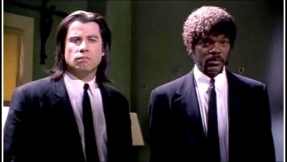 Tarantino’s magnum opus provided the film world with one of the best film duos, and also a relationship which is difficult to explain. It seems that their relationship feeds off their almost constant bickering, and questions are forged in the audiences heads, such as would either of them sacrifice themselves for the other? Does their relationship extend past that of co-workers? For the most part, there is more of a love to hate sort of relationship, and find a common ground in laughing at the world’s cruel fates.
Tarantino’s magnum opus provided the film world with one of the best film duos, and also a relationship which is difficult to explain. It seems that their relationship feeds off their almost constant bickering, and questions are forged in the audiences heads, such as would either of them sacrifice themselves for the other? Does their relationship extend past that of co-workers? For the most part, there is more of a love to hate sort of relationship, and find a common ground in laughing at the world’s cruel fates.
The central protagonists of the 1994 Pulp Fiction, where their plot jumps between retrieving an unknown package for their boss, cleaning up an unexpected “accident” and confronting a couple of restaurant robbers always provide a laugh. Whether they are arguing about foot massages, the cleanliness of bacon or the difference between fast-food outlets between countries, they are the classic fallible goons, always caught in the middle of something which they did intend to be involved in.
While they do form the comic relief, they are the moral backbone of the multi-faceted story, especially Jules’ decision to ‘walk the earth’, while Vince meets a tragic end, they show that those who help evil will more than likely meet ends by evil. Regardless of their leaving the diner being the last shot, it is likely that a bittersweet just around the corner and that shows that personality can only take you so far in life.
6. Buzz Lightyear and Woody the Cowboy (Tim Allen and Tom Hanks) in Toy Story 1,2 & 3 (1995-2010)
Woody: You are a child’s play thing!
Buzz: You are a sad, strange little man, and you have my pity. Farewell.
Woody: Oh, yeah? Well, good riddance, ya loony! – Toy Story (1995)
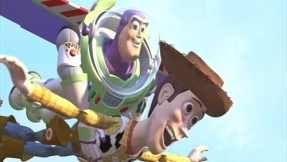 When one looks at Buzz and Woody, there needs to be a distinction made between their two different dynamics: before Buzz realises he is a “toy” and the events after (i.e. the end of Toy Story, as well as Toy Story 2 & 3). It must be said that the former is much more enjoyable to watch, while the latter is probably the best film friendship between two inhumanoid characters. There’s a certain magical style to their arguments and this is because of the quick-paced back-and-forth chemistry between Hanks and Allen. With Woody’s mocking against Buzz’s straight-faced seriousness, the battle between two people who think themselves superior to the other is just comedy gold. On the other hand, once Buzz realises he is a “toy”, they become two friends, heroes which perfectly weigh each other out, already cemented as protagonists for the coming two films.
When one looks at Buzz and Woody, there needs to be a distinction made between their two different dynamics: before Buzz realises he is a “toy” and the events after (i.e. the end of Toy Story, as well as Toy Story 2 & 3). It must be said that the former is much more enjoyable to watch, while the latter is probably the best film friendship between two inhumanoid characters. There’s a certain magical style to their arguments and this is because of the quick-paced back-and-forth chemistry between Hanks and Allen. With Woody’s mocking against Buzz’s straight-faced seriousness, the battle between two people who think themselves superior to the other is just comedy gold. On the other hand, once Buzz realises he is a “toy”, they become two friends, heroes which perfectly weigh each other out, already cemented as protagonists for the coming two films.
The Toy Story films explore the idea that toys literally “come to life” when humans are absent, personifying them essentially as adults, even with their own committees, military and romances. Along the way, the human world gets in the way of their life with their owner, Andy, as they have to escape a neighbourhood bully, retrieve Woody from a toy antique collector and escape a playschool. Still one of the best film trilogies, as well as being some of the more adult children films (namely the first), it is brilliantly carried by the two protagonists, along with a stellar supporting cast.
Central to Buzz and Woody is the audience’s gradual lack of awareness that they are toys, as they speak like people, they act like people and, more or less, they look like people. It is only when we see things in their perspective that we realise that they see life so different to our own. Thus, love is without boundaries, as even toys can love each other, and in a similar way, toys can love their owners. Yet, in the first film, Buzz considers himself, a valiant and invincible “Space Ranger”, considerably superior to that of a mere bedroom “Sherriff”. Without this difference and the realisation from both of them that there is more to life than their own beliefs, their friendship becomes one of realisation of identity, as well as survival, which is bound to take them to infinity and beyond.
5. Jeffrey “The Dude” Lebowski and Walter Sobchak (Jeff Bridges and John Goodman) in The Big Lebowski (1998)
The Dude: “What’s in the fuckin’ carrier?”
Walter: “Huh? Oh, that’s Cynthia’s dog. I think it’s a Pomeranian. I can’t leave him home alone or he eats the furniture. I’m watching him while Cynthia and Marty Ackerman are in Hawaii.”
The Dude: “You brought the fuckin’ Pomeranian bowling?”
Walter: “What do you mean brought it bowling, Dude? I didn’t rent it shoes. I’m not buying it a fucking beer. He’s not taking your fucking turn, Dude.”
The Dude: “Man, if my fuckin’ ex-wife asked me to take care of her fuckin’ dog while she and her boyfriend went to Honolulu I’d tell her to go fuck herself.”
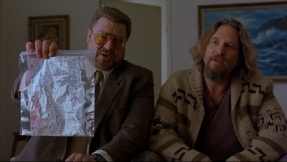 If unemployment and bowling were noble ways to live one’s life, then one would want to be just like these two. The antitheses of the “heroes” of film, “The Dude” and Walter personify everything that is wrong with humanity and the detrimental effects of nostalgia and even friendship. This would be one case where one does not need the other (they would most likely be much better off without the other) but rather it seems fateful for them to be together, and indeed it is part of this perfectly twisted story. Regardless of how they came to know each other or why they remain friends, they still are the most endearing “losers” of modern film.
If unemployment and bowling were noble ways to live one’s life, then one would want to be just like these two. The antitheses of the “heroes” of film, “The Dude” and Walter personify everything that is wrong with humanity and the detrimental effects of nostalgia and even friendship. This would be one case where one does not need the other (they would most likely be much better off without the other) but rather it seems fateful for them to be together, and indeed it is part of this perfectly twisted story. Regardless of how they came to know each other or why they remain friends, they still are the most endearing “losers” of modern film.
The Coen Brothers’ ’98 flick quite literally “tells” the story of “The Dude”, an unemployed man, who lives modestly and bowls regularly with two friends, who gets embroiled in a multi-faceted plot, filled with money owed to pornographers, beliggerent Nihilists, a kidnapped wife of a millionnaire (to which the film owes its name), all because of a simple misunderstanding and a soiled rug. However, to call the plot a necessary part of the explanation of why this film is so great is like calling tobasco sauce a necessary part of a carrot cake recipe. It is more so the characters and the crazy, erratic trip they suddenly find themselves on which makes this film such a fun ride.
Walter and “The Dude” are on two completely different sides of the spectrum, one who advocates peace, a leftover of the 60’s “hippie” movement, and who often smokes pot and the other who thinks he is still within the war, a Vietnam veteran, even going to the extreme of threatening to shoot someone over 8 points in bowling. On account of this, they do counter-act each other, while “The Dude” can not always pacify Walter, there is always a perfect balance between Walter’s crazy and “The Dude’s”…dudeness.
Perhaps the perfect example of their place in the world is near the end when Walter says to “The Dude”, “Fuck it, Dude, let’s go bowling”, even after the scarring experiences they have just emerged from. Therefore, they are two people who do not really fit anywhere, lost in time and space, stuck in their own nostalgia and really, the only familiar thing left is a bowling lane. They abide to the laws of the time, as well as they can and try to survive as anomalies in an alien world.
4. Jake and Elwood Blues (John Belushi and Dan Aykroyd) in The Blues Brothers (1980)
Elwood: “It’s 106 miles to Chicago, we got a full tank of gas, half a pack of cigarettes, it’s dark… and we’re wearing sunglasses.”
Jake: “Hit it.”
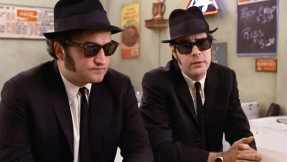 The pair that made black Ray-Bans, blues and excessive car chases in film and popular culture are also one of the best film duos. Filled with expletives, blasphemin’, singing and cracking a whip or two, Jake “Joliet” and Elwood Blues are the perfect people to root for, as they are doing bad things for a good cause. Despite their appearances being quite dissimilar, they found a common love in blues and soul music, and indeed for the home in which they were raised. They are one half of the other and any action that one takes is reciprocal; a brotherly understanding of the “con”.
The pair that made black Ray-Bans, blues and excessive car chases in film and popular culture are also one of the best film duos. Filled with expletives, blasphemin’, singing and cracking a whip or two, Jake “Joliet” and Elwood Blues are the perfect people to root for, as they are doing bad things for a good cause. Despite their appearances being quite dissimilar, they found a common love in blues and soul music, and indeed for the home in which they were raised. They are one half of the other and any action that one takes is reciprocal; a brotherly understanding of the “con”.
John Landis’ landmark 1980 film The Blues Brothers, not only a must-see for any comedy lover, but also for any music lover, is a tale about two orphan brothers, formerly part of a blues group, known as “The Blues Brothers Band”. With Jake recently out of jail, they quickly learn that the orphanage which raised them needs 5000 dollars or it will be shut down. After “seeing the light”, they justify their actions simply by saying that they are on “a mission from God”, all the while screwing over the police, a bar owner, a country band, some Neo-Nazis and doing a considerable amount of property damage. What follows can only be described as an over-the-top musical roller-coaster, where reality is surpassed constantly. Featuring some of the best comedy lines, stunts (especially the stellar car-chases) and musical numbers ever, it epitomises the excess of early 80’s film.
The characters originated from Saturday Night Live and has since then exploded into a cult phenomenon, even performing their own live shows in character, and a messy sequel in Blues Brothers 2000. The key to the film is not the group as a whole, but rather the comically straight performances of Belushi and Aykroyd, who barely break a smile or bat an eyelash during the destruction being caused around them. This is exemplified during one of the car chases, which takes place in a shopping mall, when rather than appearing agitated that they are destroying everything in the mall, they instead point out every shop they can see before crashing through its windows. They are the rebels without a care for the consequences.
Despite a lack of characterisation, there is still a bare spark between Jake and Elwood, but also a brotherly understanding that what they are doing is for the greater good, even though the reason is lost in the fun they are evidently having.
3. Marty McFly and Emmett “Doc” Brown (Michael J. Fox and Christopher Lloyd) in Back to the Future Parts 1,2 & 3 (1985-90)
Marty: “Whoa. Wait a minute, Doc. Are you trying to tell me that my mother has got the hots for me?”
Doc: “Precisely.”
Marty: “Whoa. This is heavy.”
Doc: “There’s that word again. “Heavy.” Why are things so heavy in the future? Is there a problem with the Earth’s gravitational pull?” – Back to the Future (1985)
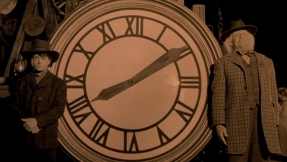 Perhaps the duo with the most inherent polarity, Marty and Doc also have a certain undefinable familiarity between them. Despite the meeting or the formation of their friendship being omitted from the audience’s perspective, there is already an instant understanding of each others world. However, perhaps the more interesting duo is that of 1985 Marty and 1955 Doc, and this is where most of the films’ comedic value comes from. As we witness Marty’s impatience and Doc slowly becoming acquainted with the confronting situation he must deal with, we see how such a friendship may have came into being. The films are not only an advocate for enduring love across time, but also enduring love across age and cultural boundaries.
Perhaps the duo with the most inherent polarity, Marty and Doc also have a certain undefinable familiarity between them. Despite the meeting or the formation of their friendship being omitted from the audience’s perspective, there is already an instant understanding of each others world. However, perhaps the more interesting duo is that of 1985 Marty and 1955 Doc, and this is where most of the films’ comedic value comes from. As we witness Marty’s impatience and Doc slowly becoming acquainted with the confronting situation he must deal with, we see how such a friendship may have came into being. The films are not only an advocate for enduring love across time, but also enduring love across age and cultural boundaries.
The Back to the Future film trilogy is a time-travel movie trilogy with a twist, as it is more concerned with the “What?” than the “Why?” (i.e. What would happen if a boy from the 80’s were to travel back to the 50’s?). Marty McFly is like any other 17 year-old: more concerned with his social life than getting to school on time, infatuated with his girlfriend, embarassed by his push-over parents. However, when his scientist/inventor friend Emmett “Doc” Brown reveals his best invention yet: a time-machine DeLorean, his life changes forever. Accidentally travelling back to 1955 and without the means to get back, as well as accidentally causing his mother to fall in love with him, he must ensure that his mother and father fall in love, before he ceases to exist. As is inevitable with all time-travel films, paradoxes and plot-holes ensue as the plot complicates itself. However, the films maintain a fun tone and a sense of adventure and create a lasting connection between the young and the old.
The most interesting dynamic between Doc and Marty is that neither is completely knowledgeable about the other, there always needs to be a reciprocal learning experience, especially between the younger Doc and Marty. This means that the usual protagonist formula is transformed, so that for the most part Doc’s dialogue is scientific and expository, yet there also needs to be a certain amount of teaching from Marty. While most of this only allows for the set-up and pay-off of jokes, it is still quite amazing to see a 65 year-old and a 17 year-old on such equal terms. Today’s films usually portray the elderly as grumpy and constantly nostalgic (i.e. “Back in my day…), and thus resentful of the current youth. However, the Back to the Future trilogy finds a balance between understanding and alienation between the two ages, an acceptance that although there are differences in actions or customs, there are the same human feelings behind them.
The Back to the Future trilogy is not only a pioneer of special effects and narrative structure, but also of characters which connect over time and space, and showed that love is without the perceived boundaries of age or cultural background.
2. Tyler Durden and ‘The Narrator’ (Brad Pitt and Edward Norton) in Fight Club (1999)
Tyler Durden: “You have to know the answer to this question! If you died right now, how would you feel about your life?”
Narrator: “I don’t know, I wouldn’t feel anything good about my life, is that what you want to hear me say? Fine. Come on!”
Tyler Durden: “Not good enough.”
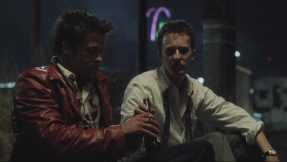 All technicalities aside, this cheeky couple did not need each other as much as they were forced together by hard times and a primal urge. Whether you think Tyler Durden was a help or a hindrance on ‘The Narrator’, he definitely had a profound effect on his life: for better or worse. The essential ingredient to this brief affair is Brad Pitt’s madcap performance of Tyler Durden, juxtaposed with Edward Norton’s helpless protagonist. Yet, it is also his own inner conflict as to whether what he has caused is justified: they created ‘Fight Club’ during a time of stagnancy, in order to incite change. As Tyler grows beyond control, ‘The Narrator’ realises that he can now only watch as the situation he was part of, and technically created, destroys what he has become to see as valuable.
All technicalities aside, this cheeky couple did not need each other as much as they were forced together by hard times and a primal urge. Whether you think Tyler Durden was a help or a hindrance on ‘The Narrator’, he definitely had a profound effect on his life: for better or worse. The essential ingredient to this brief affair is Brad Pitt’s madcap performance of Tyler Durden, juxtaposed with Edward Norton’s helpless protagonist. Yet, it is also his own inner conflict as to whether what he has caused is justified: they created ‘Fight Club’ during a time of stagnancy, in order to incite change. As Tyler grows beyond control, ‘The Narrator’ realises that he can now only watch as the situation he was part of, and technically created, destroys what he has become to see as valuable.
David Fincher’s landmark 1999 film Fight Club, told from the perspective of the nameless protagonist, widely known as either ‘The Narrator’ or ‘Jack’, a insurance assessor for a major car company, who, suffering from insomnia, decides to pretend to be dying to experience catharsis as he attends self-help classes for various terminal diseases. On a business trip, he meets Tyler Durden, a erratic, rebellious boy-man, and later, they simply decide to fight outside a bar for no reason. Thus, ‘Fight Club’ is created, a congregation of the left-overs of the 90’s, without a place in time or space, where the only rules are secrecy and a restricted amount of decorum on the hard concrete where they fight. Yet, to call Fight Club a fighting movie is like calling The Big Lebowski a bowling movie, and the fighting is more of a metaphor for the post-adolescent and anti-capitalist angst which the movie’s protagonists hold.
As much as it is ‘The Narrator’ is who we are rooting for to overcome his moral battle against the beast he conceived, there is a little part in our head which wants ‘Project Mayhem’ to win its own battle against the constrictions of modern society. Consequently, Tyler Durden is really a manifestation of everything that we wish we could do, but are restricted by our own moral codes. It is this inner juxtaposition within Fight Club and between Tyler and ‘The Narrator’ which makes the film still relevant (mostly for dissatisfied teenagers or middle-aged men who feel disconnected from others). ‘The Narrator’ is the goody-two-shoes person, who symbolises the majority of the world and Tyler is that section of the population which forces others to truly see the corruption of the world. He not only wants to see the world burn, he wants to be wielding the flamethrower.
While the film doesn’t explictly state that Tyler is bad or good, it makes more of an argument for individuality, and a restrained level of rebellion, not only against government or order, but against the perceived ideas of male identity and our place in the world. Perhaps the most morally interesting duo on film, ‘The Narrator’ and Tyler Durden make up a mirror held up to society, cracked down the middle, showing us there is always that part of us which wants to see more graphic nudity in a Disney movie.
1. Frodo Baggins and Samwise Gamgee (Elijah Wood and Sean Astin) in The Lord of the Rings: The Fellowship of the Ring, The Two Towers and The Return of the King (2001-3)
Sam: “Do you remember the Shire, Mr. Frodo? It’ll be spring soon. And the orchards will be in blossom. And the birds will be nesting in the hazel thicket. And they’ll be sowing the summer barley in the lower fields and eating the first of the strawberries with cream. Do you remember the taste of strawberries?”
Frodo: “No, Sam. I can’t recall the taste of food, nor the sound of water, nor the touch of grass. I’m naked in the dark, with nothing, no veil between me and the wheel of fire! I can see him with my waking eyes!”
Sam: “Then let us be rid of it, once and for all! Come on, Mr. Frodo. I can’t carry it for you, but I can carry you!
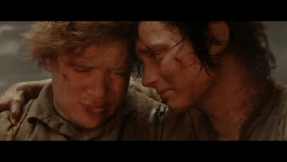 Despite Frodo and Sam being the closest duo on this list to being a romantic couple, with all hobbit-related homo-erotic jokes aside, they are the epitome of ‘friendship through adversity’. Across all 3 films, they have traversed several hundreds of miles across rough terrain, encountered a treacherous guide, several Nazgul, a haunted swamp, a giant spider and Sauron himself, all while the power of the “One Ring” grows stronger. One wouldn’t like to go on such a journey with someone who they didn’t get along with, and luckily Frodo has Sam, his trusty gardener and loyal companion. Once they are on their way to Bree, their connection is almost instantaneous, as Sam sees his cause as a noble one for his ‘master’, but also becomes one of adventure and friendship. This is exemplified via the quote: ‘I made a promise, Mr Frodo. A promise. “Don’t you leave him Samwise Gamgee.” And I don’t mean to. I don’t mean to.’, and it is this promise which is the knot which holds their relationship together, throughout several hardships.
Despite Frodo and Sam being the closest duo on this list to being a romantic couple, with all hobbit-related homo-erotic jokes aside, they are the epitome of ‘friendship through adversity’. Across all 3 films, they have traversed several hundreds of miles across rough terrain, encountered a treacherous guide, several Nazgul, a haunted swamp, a giant spider and Sauron himself, all while the power of the “One Ring” grows stronger. One wouldn’t like to go on such a journey with someone who they didn’t get along with, and luckily Frodo has Sam, his trusty gardener and loyal companion. Once they are on their way to Bree, their connection is almost instantaneous, as Sam sees his cause as a noble one for his ‘master’, but also becomes one of adventure and friendship. This is exemplified via the quote: ‘I made a promise, Mr Frodo. A promise. “Don’t you leave him Samwise Gamgee.” And I don’t mean to. I don’t mean to.’, and it is this promise which is the knot which holds their relationship together, throughout several hardships.
If you don’t know the story to The Lord of the Rings, get out of your cryogenic chamber and watch them. While essentially made up of a very simple premise, the universe created in both Peter Jackson’s film trilogy and the book trilogy (written by J.R.R. Tolkien) which the films were based on is leviathan to say the least. The film trilogy follows the main protagonist, Frodo Baggins (Elijah Wood), a humanoid creature (the height of a child) who live their lives simply in a simple village called ‘The Shire’, oblivious to the evil just outside their doorsteps. Frodo’s uncle leaves him a ring after he leaves to go exploring Middle-Earth (a land mass on ancient Earth or Arda in Tolkien’s books), unaware that it is the most powerful ring one can hold; forged by a ‘Dark Lord’ called Sauron to hold all the power of the world. With help from a group of other characters, including a man (the heir to a kingdom) called Aragorn (Viggo Mortensen), an elf, Legolas (Orlando Bloom), a dwarf, Gimli (John Rhys-Davies), another heir to the throne, Boromir (Sean Bean), a wizard named Gandalf (Ian McKellen), as well as Frodo’s friends Sam (Sean Astin), Merry (Dominic Monaghan) and Pippin (Billy Boyd), thus forming the ‘Fellowship of the Ring’, aiming to get the ring to the place which it was forged, a volcano named Mount Doom in Sauron’s land, Mordor. From there, it is a constant battle of good against evil, as Sam and Frodo trek their way to Mordor without being seen by Sauron.
The most prevalent theme of Jackson’s film trilogy is that ordinary people can do extraordinary things, and that size and strength is not always everything. Frodo and Sam evidently portray this idea, always continuing on their quest for the greater good, rather than their own desires or greediness. Regardless of how the ring tries to corrupt Frodo or no matter how bleak their outlook is, they proceed not only for others, but for each other. There are moments where Sam must pick Frodo up (pun intended) and, conversely, when Sam is despondent about their journey. However, there is always the right amount of space between those cute moments where they look at each other and Frodo says ‘Sam’ in only the way that he can and you can’t help but smile. Regardless of how awkward some of the scenes may be, especially the final scene of The Two Towers (2002), in which Frodo is speculating how people will talk about the pair after their quest is completed, there is also a palpable male love, painfully absent from most films. The film trilogy presented a new and refreshing way to show a close friendship on film, without the usual inferences of homosexuality. While people did presume that they had some relationship, as made evident in the various fan-fictions out there, they are more an amalgamation of brothers, friends, a master and servant (not in the S&M sense) and will probably be in each others minds and in our minds as the best film duo until the end of all things.
Who do you consider to be the best film duo of all time? What makes a good duo? All opinions will be taken into account, as all bias was included within this article. Therefore, please comment as much or as long as you wish and I guarantee I will respond to all queries and criticisms.
What do you think? Leave a comment.










Great article! Good chemistry between lead and/or supporting characters can make a terrible film seem relatively watchable. The actors have to melt into their roles in order for their dynamic to payoff. Lethal Weapon, for example, has two damaged yet masculine cops who use their power and guile to stop the baddies and help one another through multiple situations.
Never seen Lethal Weapon, so didn’t put it on my list, have to watch it soon.
Pitt and Norton is a pleasant surprise but very deserving. Thanks for having Back to the Future there, must choice!
Can’t have a list without those two, thanks for the feedback.
Vega and Winfield work because they continually try to prove their worth to themselves and the bad guys. The first scene with the two of them involves an argument that establishes their morals and power. However, they understand each other and get the job done.
Totally agree, perfect dynamic between trivial conversations between themselves and biblical speeches to those they are trying to intimidate.
What about Thelma And Louise? Or Lorelei and Dorothy?
Never seen either of those films, though I know that the list is very sexist, and I apologise for that. Have to get on to watching these films.
Good writing, kept me engaged throughout. My picks are:
3) Jay + Silent Bob
2) Andy + Red (Shawshank Redemption)
1) WALL•E + EVE
Andy and Red were definitely in my Top 20 and ultimately, they should be there. Same with Wall-E and EVE, never seen any films featuring Jay and Silent Bob, I know that must sound like blasphemy, but I intend to watch Clerks very soon. Thanks for the feedback.
You nailed number one. Sam and Frodo get my vote every time. Sure, they have the unfair advantage of over ten hours of movie for their relationship to grow, but it’s still one of the most genuinely touching friendships I’ve seen onscreen. “I can’t carry it for you…but I can carry you” is the best part of the trilogy for me.
Nice to see you selling some of your more interesting choices very well. Walter and The Dude aren’t one I’d normally consider – primarily because The Dude is pure icon and outshines everyone else in the movie – but I like that you gave the pair a mention.
I don’t envy you doing this list; there are so many great duos. I liked this article so much that I won’t harp on for 1000 words about how you didn’t put Kirk and Spock in there…
Thanks for the feedback. I am not a Star Trek fan, the only thing I have seen in relation to this universe is the 2009 reboot and the RedLetterMedia reviews. However, hopefully in the future, I will get on to seeing the films and TV series. I apologise for not featuring them, as I know most people do consider them the greatest, but I didn’t feel I could do them justice without being a completely well-viewed fan of the universe, and thus, they were omitted.
Don’t apologise buddy, stick to your guns! You’ve made a great list here; I am but a lowly nerd…thanks for the entertaining article.
Martin Riggs and Roger Murtaugh from Lethal Weapon should have a spot here.
Have not seen any of the Lethal Weapon films, will do soon.
I really enjoyed this article. Great addition with Raoul Duke.
Cheers mate
This was a fun one.
I liked the inclusion of the dud and the ‘duo’ in fight club.
Thanks
OK so maybe you only watch male films from the U.S.? Because you’ve missed so many great duos like Elisabeth and Alma from Persona, Benigno and Marco from Talk to Her, or Julio and Tenoch from Y Tu Mama También? What about Butch Cassidy and the Sundance Kid, which should be right up your alley? Otherwise, I enjoyed most of the ones you have listed (especially Marty and the Doc!)
Once again, I apologise for not being more film-literate and any sexism was not intentional. I will try and watch these films, and I also knew someone would bring up Butch Cassidy and the Sundance Kid (which I haven’t seen).
Great pick for number one!! I loved all the duos for that matter. They all offer something to one another.
Thanks
Frodo and Sam, great choice for #1,
It was a tough pick between No. 2 and No. 1, but it had to be Frodo and Sam
Some great choices here. Definitely going to watch Pulp Fiction again tonight, Jackson and Travolta are superb.
Cheers mate
I have heard of most of these films and given the films that I have heard of have some gravitas as to legacy, I think that this is a well thought out list.